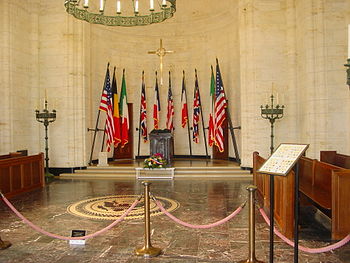- American Expeditionary Force
-
 Pour les articles homonymes, voir Corps expéditionnaire.
Pour les articles homonymes, voir Corps expéditionnaire.AEF 
mémorial de l'offensive Meuse Argonne à Romagne-sous-Montfaucon.Période 3 mai 1917 – ? ? 1919 Pays  États-Unis
États-UnisBranche Armée de Terre Type Armée Rôle Coordination des unités américaines contre la Triplice Effectif jusqu'à deux millions personnes Fait partie de Armées Alliées
Front de l'OuestComposée de 17e DIC, 8e régiment de marche de chasseurs d'Afrique Garnison Chaumont Inscriptions sur l’emblème le 11 novembre Guerres Première Guerre mondiale Batailles Troisième bataille de l'Aisne
Saillant de Saint-Mihiel
Offensive Meuse-ArgonneCommandant Frederick Funston
John PershingCommandant historique John Pershing modifier 
L'American Expeditionary Force (ou AEF) était le nom donné au corps expéditionnaire américain durant la Première Guerre mondiale constitué le 3 mai 1917 et dissout en 1919. Ce corps expéditionnaire était sous les ordres du général John J. Pershing nommé à ce poste après le décès soudain le 19 février 1917 du général Frederick Funston, primitivement désigné a ce poste par le président Woodrow Wilson en prévision de l'entrée en guerre contre l'Empire allemand.
Sommaire
Déploiement
Au 1er janvier 1918, il y a 150 000 soldats américains en France, le 11 novembre 1918, on dénombrait environ 2 millions d'hommes venus des États-Unis en Europe pour aider la France et ses alliés dans les tranchées, dans les rangs de l'United States Army.
Engagements
Il c'est particulièrement illustré au Saillant de Saint-Mihiel les 2 et 3 septembre 1918. Avant il avait été engagé dans la Troisième bataille de l'Aisne qui comprenaient les Bataille du bois Belleau et de la Bataille de Château-Thierry (1918). Ensuite il participa à l'Offensive Meuse-Argonne qui mena à la victoire du 11 novembre.
Répartition ethnique
Leur répartition raciale se faisait ainsi:
- ~ 1 700 000 Blancs
- ~ 200 000 Afro-américains qui furent regroupés dans des unités spéciales pour cause de ségrégation, l'immense majorité servit dans des unités de logistique, seuls 20% dans des unités de combat, dont la 93e division d'infanterie (États-Unis),
- 17 313 amérindiens furent incorporés dans l'US Army, (14 000 sont envoyés en France)
Unités
Liste des unités engagées : 1re, 2e, 4e, 26e, 26e, 27e, 28e, 29e, 30e, 30e, 31e, 33e, 36e, 37e, 42e, 77e, 78e, 82e, 89e, 91e, 93e, 157e divisions, l'air service et le corps de Chars[2].
Hommage
Une cérémonie eu lieu le 11 novembre 1921 à Châlons-sur-Marne où fut choisi le soldat inconnu du corps expéditionnaire américain. Choisi par le sergent Edward F Younger du 50e régiment d'infanterie en présence des généraux américain Allen et Rogers du général français Duport, décoré de la Légion d'honneur par Maginot le corps parti aux États-Unis sur le Olympia. Il fut amené au cimetière d'Arlington accompagné par WIlson, Pershing et le président Harding .
Notes et références
- Historia, n°635 (septembre 1999)
- non exhaustive
Liens internes
- États-Unis pendant la Première Guerre mondiale
- Général John Pershing, commandant l'American Expeditionary Force
- 2e division d'infanterie (États-Unis)
- 91e division d'infanterie (États-Unis)
- Bataille du bois Belleau
- Escadrille La Fayette
- Westerveldt Board
- Alliés de la Première Guerre mondiale
- (en) Formations of the United States Army during World War I
Liens externes
Catégories :- Histoire militaire des États-Unis
- Unité militaire de la Première Guerre mondiale
- 1918
- United States Army
Wikimedia Foundation. 2010.





